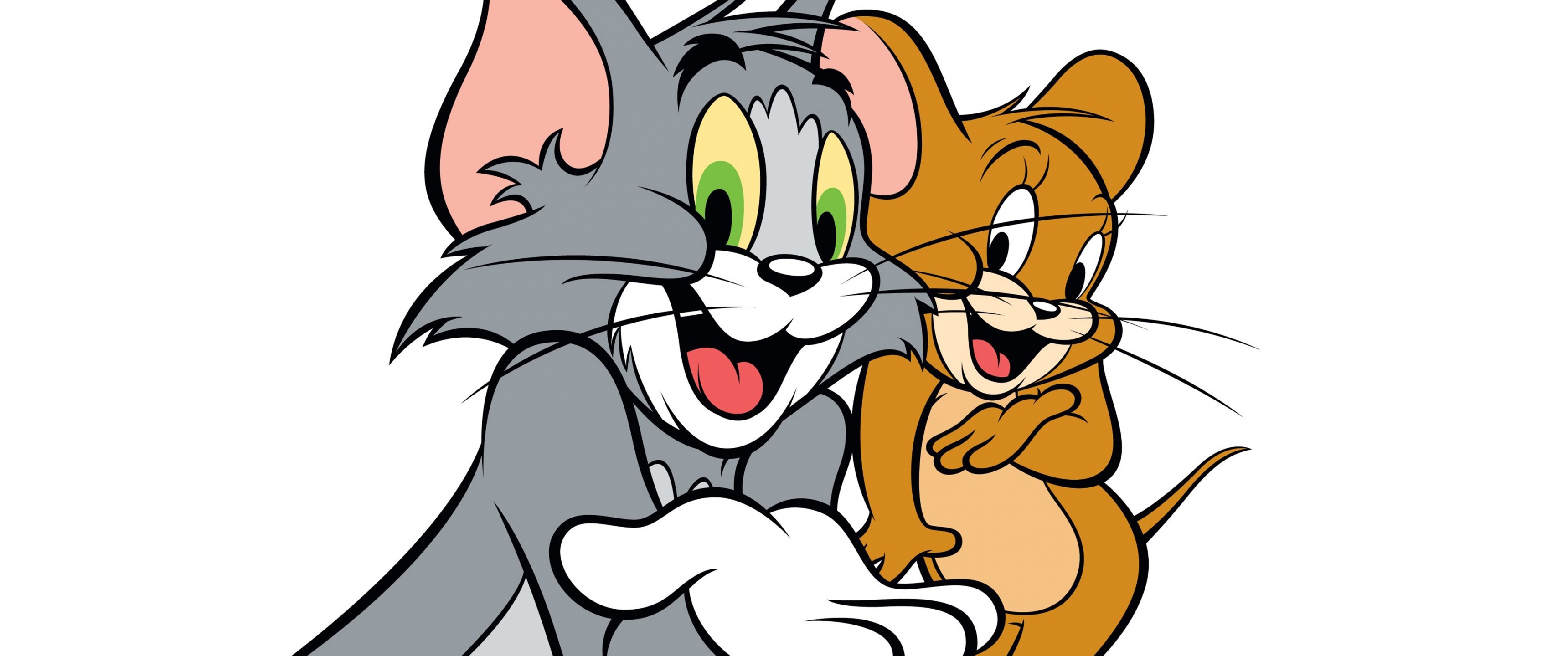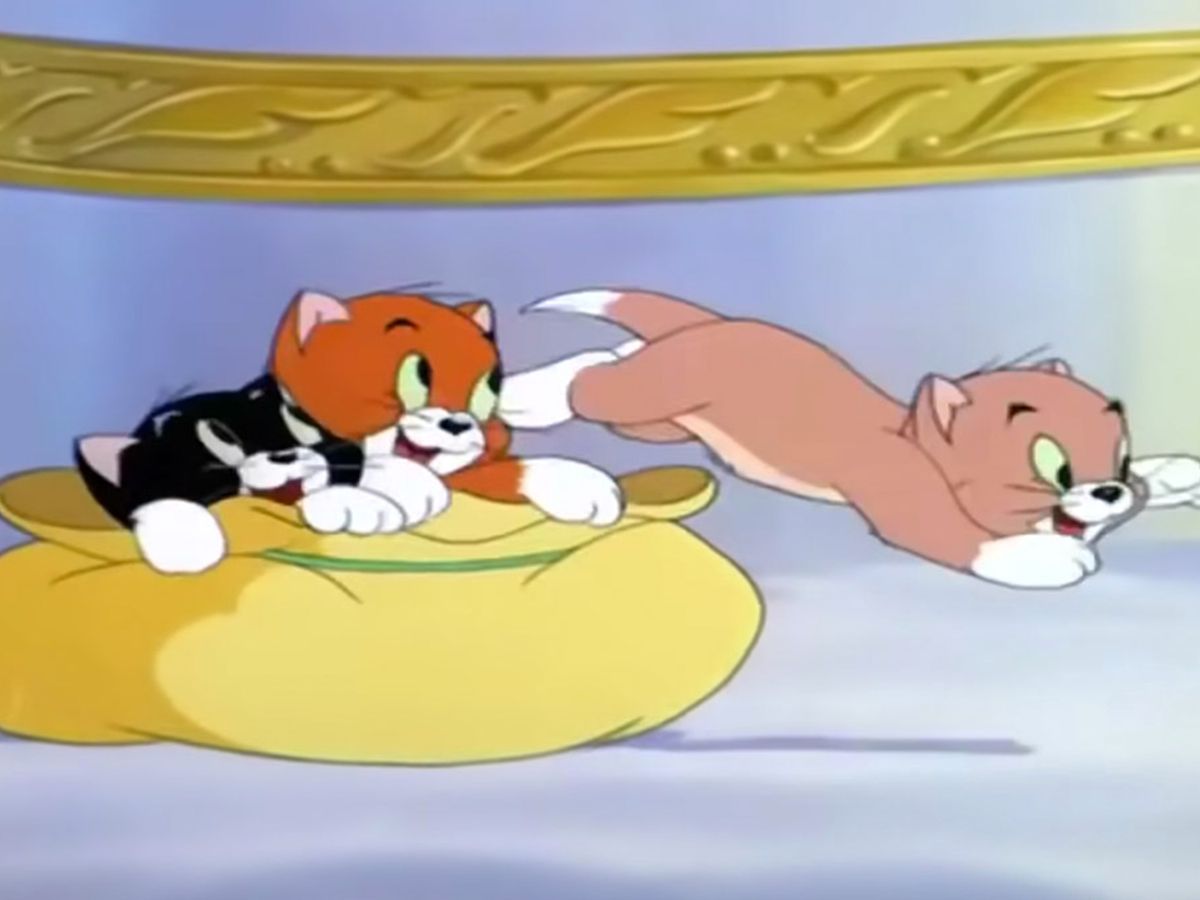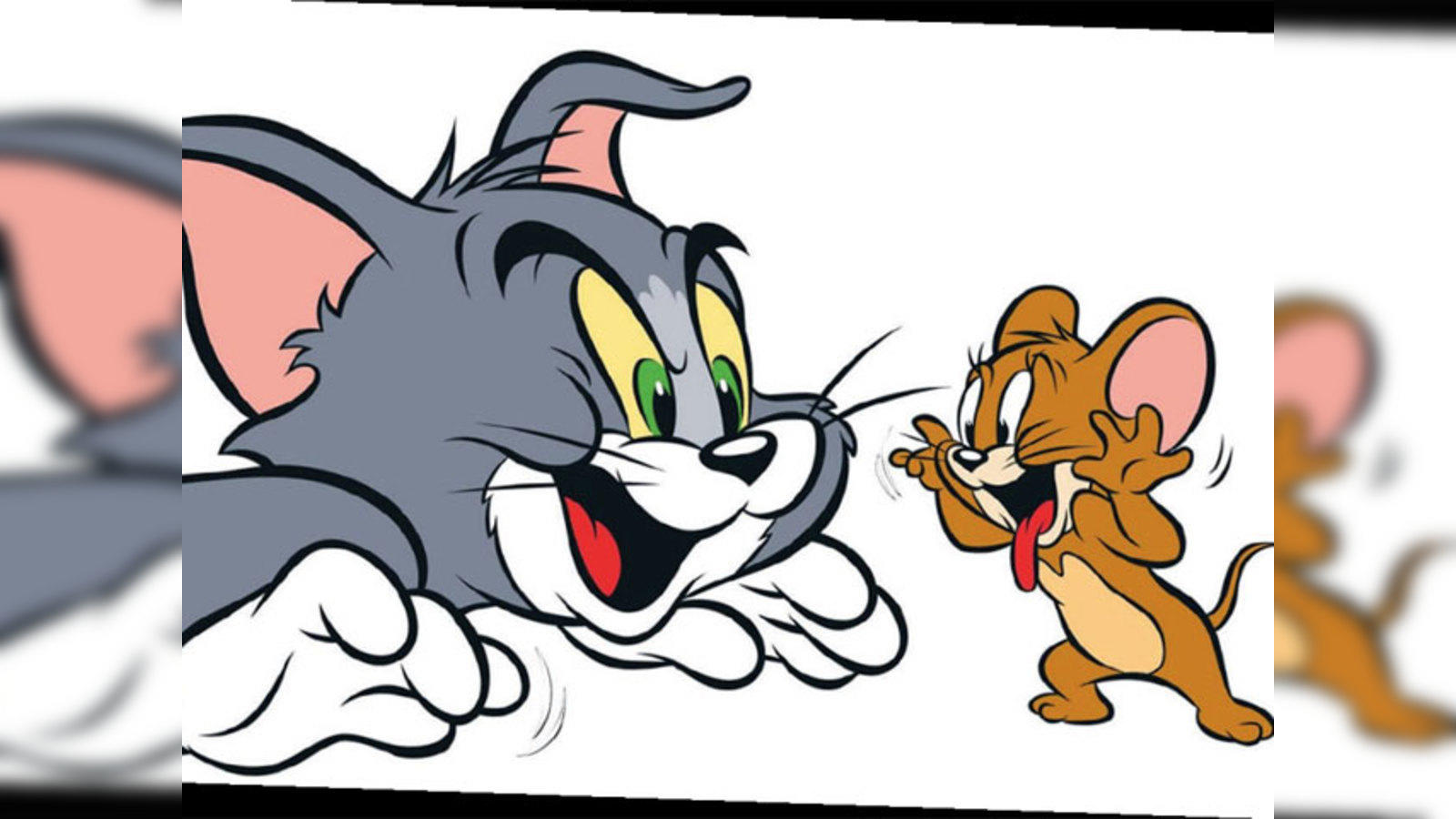Have you ever found yourself completely engrossed in a cartoon, laughing out loud, even when there are hardly any spoken words? It's almost as if the characters are speaking a universal tongue, one that doesn't need sound to make its point. This feeling often comes up when thinking about classic cartoons, especially those that rely heavily on physical gags and exaggerated reactions. The question of whether a show like Tom and Jerry was made for deaf people pops up quite a bit, and it’s a really interesting thought to explore, isn't it?
For decades, this cat and mouse duo has brought smiles to faces all over the globe, regardless of what language someone speaks or whether they can hear. Their antics, chases, and endless attempts to outsmart each other are told through pure action and expression. There's something quite special about how they convey so much without ever uttering a single line of dialogue that truly matters to the plot. It makes you wonder, you know, how much of that was on purpose?
This enduring appeal, which seems to cross so many barriers, gets us thinking about the way stories are told. When a show relies so much on what you see, on the way characters move and react, it opens up a conversation about how everyone can enjoy it. It's a pretty neat thing to consider, especially in a world that's always trying to be more welcoming to all sorts of folks. So, let's take a closer look at what makes Tom and Jerry so widely loved and whether its unique style of communication played a part in reaching a broader audience, perhaps even those who experience the world without sound.
Table of Contents
- The Silent Laughter - How Tom and Jerry Communicates
- Did Creators Intend for Deaf Audiences?
- What Makes Tom and Jerry so Visually Expressive?
- How Does Sound Play a Role, if Any, in Tom and Jerry?
- The Universal Appeal of Tom and Jerry - Was Tom and Jerry Made for Deaf People?
- Why Does Visual Comedy Work So Well?
- Is Tom and Jerry an Example of Accessible Media?
- Beyond the Gags - The Enduring Legacy of Tom and Jerry
The Silent Laughter - How Tom and Jerry Communicates
When you sit down to watch an episode of Tom and Jerry, it's pretty clear that spoken words are not the main way the story unfolds. You'll hear plenty of screams, yelps, and the occasional mumbled phrase, but the true essence of the humor and the plot comes from what you actually see. This reliance on physical comedy, on the actions and reactions of the characters, is a huge part of its charm. It's a bit like watching a very old silent movie, where the actors had to use their entire bodies to show what they were feeling or what was happening in the story. So, in a way, it’s a language everyone can pick up on.
The animators, it seems, put a lot of thought into how Tom's eyes would pop out when surprised, or how Jerry's tiny frame could cause such big trouble. Every squash, stretch, and exaggerated movement tells a part of the story. You don't need to hear a character say, "Oh no, a piano is about to fall on me!" because you can see the wide-eyed terror, the frantic scrambling, and the giant shadow getting closer. This kind of storytelling makes the humor very direct and immediate, which is something that really connects with people, no matter their background. It’s a pretty clever approach, actually.
This method of sharing a story, where the visual information carries nearly all the weight, naturally makes the show quite open to those who cannot hear. If the core jokes and plot points depend on seeing rather than hearing, then the absence of sound doesn't take away from the experience in the same way it might for a show full of dialogue. It just means that the humor is presented in a way that is already very inclusive. You just sort of get it, you know?
Did Creators Intend for Deaf Audiences?
It's a really good question to ask whether William Hanna and Joseph Barbera, the original creators, had deaf audiences specifically in mind when they first brought Tom and Jerry to life. While there's no widely known statement from them saying, "We made this for people who are deaf," their choice to focus on visual humor was a common practice in early animation. Think about the cartoons that came before them; many relied on slapstick and physical gags because sound technology was still quite new or not always universally available. It was, you know, a practical choice for widespread appeal.
The goal for many early animators was to create something that could be enjoyed by the largest possible audience, both at home and abroad. Dialogue, obviously, creates language barriers. But a cat getting hit by a frying pan? That's funny in any language. So, while it might not have been an explicit intention to make the show for deaf people, the style they chose certainly made it highly accessible to them, as well as to children who hadn't learned to read yet, or people in countries where English wasn't spoken. It was, in a way, a very smart business move for global reach.
So, it seems more likely that the decision to minimize spoken words was driven by a desire for universal appeal and the tradition of visual comedy in animation, rather than a specific focus on the deaf community. However, the happy outcome of this creative choice is that the show naturally became something that many people, including those who are deaf, could fully appreciate. It just sort of worked out that way, you know?
What Makes Tom and Jerry so Visually Expressive?
The sheer expressiveness of Tom and Jerry comes from several key elements that work together beautifully. First off, the character designs themselves are very clear and easy to read. Tom's big, wide eyes and stretchy face can show a huge range of feelings, from pure joy to utter terror or deep frustration. Jerry, being smaller, often uses his whole body to convey emotion, scampering with delight or shrinking in fear. It's almost like they are constantly acting with their entire being, which is really something to watch.
Then there's the animation itself, which often uses what's called "squash and stretch." This technique makes characters appear to deform in exaggerated ways when they move or are hit, making impacts feel more powerful and movements more fluid. When Tom gets flattened like a pancake, you don't need words to know he's in pain or shock; the visual distortion tells the whole story. This method really pushes the boundaries of what a character can do, making the physical comedy land with a big impact. It’s a very effective way to get a laugh, too.
Also, the setting and props play a huge part. The environments are often very detailed and interactive, providing endless opportunities for gags. A simple kitchen can become a battlefield with rolling pins, cheese graters, and even household appliances becoming part of the chase. The way objects react, like a vase shattering just so, or a spring popping out of a broken chair, adds to the visual narrative. It's all about showing, not telling, and that makes it very engaging for anyone watching. It's pretty cool, actually, how much thought went into every little thing.
How Does Sound Play a Role, if Any, in Tom and Jerry?
While Tom and Jerry might be famous for its lack of spoken words, sound effects are actually a really big part of its identity. Think about it: the "boing" of a spring, the "smash" of a plate, the "whoosh" of a character flying through the air, or the classic "thwack" of a frying pan hitting someone's head. These sounds are not just background noise; they are carefully timed to make the visual gags even funnier. They add a layer of impact and rhythm to the physical comedy, making the actions feel more real, or at least, more comically exaggerated. So, too, it's almost like the sounds are characters themselves, reacting to what’s happening.
The music, too, plays a very important role. It often acts like another narrator, telling you what mood the scene is in or what's about to happen. A suspenseful string section might build as Tom sneaks up on Jerry, or a fast, playful tune might accompany a chaotic chase. The musical cues often mirror the characters' emotions and actions, adding depth to the visual story without needing dialogue. It's a very clever way to guide the audience's feelings and expectations. This makes the overall experience richer, you know?
However, it's important to point out that while these sounds and musical pieces enhance the experience, they aren't strictly necessary for understanding the plot. You could watch an episode with the sound off and still follow the main events and laugh at the jokes. The physical actions and facial expressions are so clear that the story still makes perfect sense. So, in some respects, the sound is a bonus, a really great addition, but not the core of what makes Tom and Jerry work. It's just a little extra something that makes it pop.
The Universal Appeal of Tom and Jerry - Was Tom and Jerry Made for Deaf People?
The enduring popularity of Tom and Jerry across different cultures and generations really speaks to its universal appeal. This cartoon has been a favorite for so many years, and a big part of that is its ability to make people laugh without needing a common language. Whether you're watching it in Japan, Brazil, or the United States, the humor translates because it's based on human (or, well, cat and mouse) experiences that everyone can relate to: frustration, triumph, pain, and mischief. It's pretty amazing, actually, how well it travels.
The simple premise of a cat trying to catch a mouse, and the mouse always finding a way to outsmart the cat, is something that doesn't need a lot of explanation. It's a classic underdog story, in a way, with endless variations. This straightforward narrative, combined with the clear visual storytelling, means that cultural differences don't get in the way of enjoyment. It’s almost like a shared global experience, which is rather unique for a piece of entertainment. You just get it, no matter where you're from.
So, while it wasn't explicitly created for deaf people, the elements that give Tom and Jerry its universal appeal—its visual focus, its reliance on physical comedy, and its simple, relatable plots—are exactly what make it so accessible to the deaf community. It's a happy coincidence, perhaps, that a show aiming for broad appeal ended up being so inclusive. It really shows how powerful visual communication can be when it's done well. It's truly a testament to the skill of its creators.
Why Does Visual Comedy Work So Well?
Visual comedy, or slapstick, has a long and successful history, from silent films starring Buster Keaton and Charlie Chaplin to modern animated shorts. It works so well because it taps into a very basic human response. Seeing someone slip on a banana peel, or get hit by a pie, is often instinctively funny. There's a surprise element, a bit of chaos, and the exaggeration of pain that makes us chuckle, especially when we know no one is truly hurt. It's a kind of humor that doesn't require complex thought or cultural context; it's just raw, immediate, and often very silly. So, too, it’s almost like a primal form of amusement.
In Tom and Jerry, the visual gags are often taken to absurd extremes, which makes them even funnier. Characters can be flattened, stretched, or blown up, only to return to normal in the next scene, ready for more mischief. This lack of lasting consequences allows the animators to push the boundaries of what's possible, creating truly outlandish and memorable moments. This kind of over-the-top action is inherently entertaining and easy to follow, making the humor accessible to a very wide range of ages and backgrounds. It’s pretty clever, honestly, how they pull it off.
Moreover, visual comedy is often about timing. The pause before a big fall, the quick reaction, the precise moment an object hits its mark—all these elements are carefully choreographed to maximize the comedic effect. Even without sound, the visual rhythm of the gags can be incredibly effective. It’s like a well-played piece of music, where every note is in its right place, only here, the "notes" are actions and reactions. This precision is a big part of why the humor lands so consistently. You just sort of feel the rhythm of it.
Is Tom and Jerry an Example of Accessible Media?
When we talk about accessible media, we usually mean content that can be enjoyed by people with various disabilities. In the context of Tom and Jerry, its strong reliance on visual storytelling makes it, perhaps unintentionally, a great example of media that is very accessible to deaf and hard-of-hearing audiences. Because the plot and humor don't depend on spoken dialogue, viewers who cannot hear are not missing out on the core experience. They can follow the story, understand the jokes, and enjoy the characters' antics just as much as anyone else. It's a very clear way to share a story, you know?
This natural accessibility is a powerful thing. It means that a show created decades ago, without explicit accessibility guidelines in mind, still manages to be inclusive simply because of its artistic choices. It highlights how focusing on strong visual narratives can benefit everyone, not just a specific group. It's a reminder that good storytelling, told through clear and expressive means, can break down barriers that might otherwise exist. It's pretty cool, actually, how that works out.
While modern media often adds captions, audio descriptions, or sign language interpreters to make content accessible, Tom and Jerry stands out because its very nature makes those additions less critical for basic enjoyment. The visual language is so complete that it provides a full experience on its own. This makes it a valuable piece of entertainment for many different people, truly showing the power of universal design, even if it wasn't called that at the time. It's a bit like a happy accident, in a way.
Beyond the Gags - The Enduring Legacy of Tom and Jerry
The lasting impact of Tom and Jerry goes far beyond just its funny gags and clever chases. It has become a cultural icon, recognized and loved by people of all ages and from all corners of the world. Its ability to communicate through pure action and expression has given it a timeless quality, allowing it to remain fresh and entertaining for new generations, even decades after its creation. This kind of staying power is pretty rare, you know, for any piece of entertainment.
The show's influence can be seen in countless other cartoons and comedic works that followed, many of which adopted similar styles of visual humor and minimal dialogue. It taught animators and storytellers the power of showing rather than telling, and how much emotion and laughter can be conveyed without a single spoken word. It's a testament to the idea that truly great storytelling doesn't need to be complicated; it just needs to be clear, engaging, and, in this case, very, very funny. It's a pretty big deal, actually, what they accomplished.
So, while Tom and Jerry might not have been explicitly "made for deaf people," its unique approach to storytelling certainly made it incredibly welcoming and enjoyable for them, as well as for a vast global audience. Its legacy is one of universal laughter, proving that a good chase, a clever trick, and a well-timed pratfall can speak volumes to everyone, regardless of how they experience the world. It’s a pretty neat thing to think about, isn’t it?



Detail Author:
- Name : Augustus Braun Jr.
- Username : casper.emil
- Email : makenzie54@hotmail.com
- Birthdate : 1978-09-20
- Address : 10340 Arno Plains Apt. 899 Leilaniport, RI 25981-6514
- Phone : 845.630.1927
- Company : Cronin-Abernathy
- Job : Creative Writer
- Bio : Id iusto saepe et eum modi dolore ipsa. Voluptas dolores necessitatibus eos voluptatem doloribus corporis eos nesciunt. Blanditiis accusantium similique harum in.
Socials
tiktok:
- url : https://tiktok.com/@shyanneshanahan
- username : shyanneshanahan
- bio : Qui vero dolorum aut dolore et quo consequatur.
- followers : 4104
- following : 2385
facebook:
- url : https://facebook.com/shyanne_shanahan
- username : shyanne_shanahan
- bio : Ipsam velit voluptatem velit non laudantium.
- followers : 5961
- following : 2938

